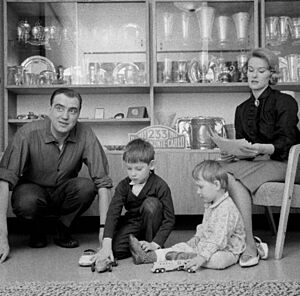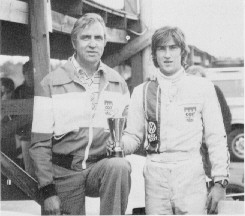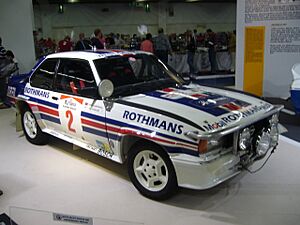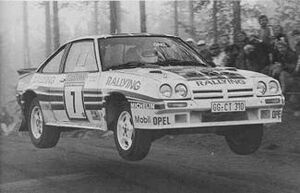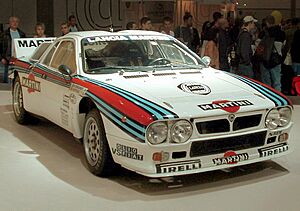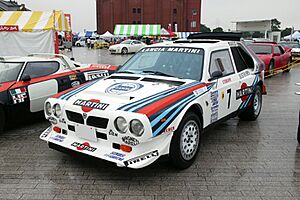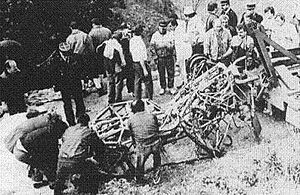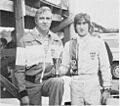Henri Toivonen facts for kids

Henri Toivonen during his Martini Racing era
|
|
| Personal information | |
|---|---|
| Nationality | Finnish |
| Born | 25 August 1956 Jyväskylä, Finland |
| Died | 2 May 1986 (aged 29) Corsica, France |
| World Rally Championship record | |
| Active years | 1975–1986 |
| Co-driver | |
| Teams | Talbot, Opel, Porsche, Lancia |
| Rallies | 40 |
| Championships | 0 |
| Rally wins | 3 |
| Podiums | 9 |
| Stage wins | 185 |
| Total points | 194 |
| First rally | 1975 1000 Lakes Rally |
| First win | 1980 Lombard RAC Rally |
| Last win | 1986 Monte Carlo Rally |
| Last rally | 1986 Tour de Corse |
Henri Toivonen (born August 25, 1956 – died May 2, 1986) was a famous Finnish rally driver. He was born in Jyväskylä, Finland, which is known as the home of the Rally Finland event. His father, Pauli Toivonen, was also a European Rally Champion in 1968, and his brother, Harri Toivonen, became a professional circuit racer.
Henri Toivonen achieved his first victory in the World Rally Championship (WRC) in 1980 at the Lombard RAC Rally in Great Britain. He was driving a Talbot Sunbeam Lotus and was just 24 years old. This made him the youngest driver ever to win a world rally at that time. Later, his countryman Jari-Matti Latvala broke this record in 2008.
After racing for teams like Opel and Porsche, Toivonen joined Lancia. He had a serious crash in 1985 that almost left him unable to move, but he bravely returned to rallying later that year. He won the last event of 1985, the RAC Rally, and then the first race of 1986, the Monte Carlo Rally. His father had won the Monte Carlo Rally exactly 20 years before him.
Sadly, Henri Toivonen died in a crash on May 2, 1986, while leading the Tour de Corse rally in Corsica. His co-driver, Sergio Cresto, also died in the accident when their Lancia Delta S4 car fell into a ravine and caught fire. There were no close witnesses to the crash, and the car was completely destroyed, making it hard to know exactly what happened. Soon after, Jean-Marie Balestre, the head of the motorsport organization FISA, banned the powerful Group B rally cars from competing the next season. This decision ended an exciting but dangerous era of rally racing.
Toivonen also started his career in circuit racing and was very good on paved roads. He raced successfully in sports car events and even impressed in a Formula One test. The annual Race of Champions, a special event for top drivers, was created in his memory. The winner of this event receives the Henri Toivonen Memorial Trophy.
Contents
Early Racing Days
Henri Toivonen grew up with strong connections to rallying. He was born in Jyväskylä, the city that has hosted the famous Rally Finland since 1951. His father, Pauli Toivonen, was a very successful international rally driver. He won major rallies like the Monte Carlo Rally and became the 1968 European Rally Champion.
Henri learned to drive when he was only five years old. Even with his family's rally background, he first started competing in circuit racing. He began with karting and then moved to touring cars, winning the Finnish Cup. He then raced in Formula Vee and Formula Super Vee, winning races and becoming the 1977 Finnish Champion in Formula Vee.
Because his family was worried about how safe circuit racing was, he decided to switch to rallying full-time. Interestingly, the kart Henri used was later bought by the parents of a 6-year-old Mika Häkkinen, who would later become a two-time Formula One World Champion.
Due to Finnish laws at the time, new drivers couldn't drive faster than 80 kilometers per hour (about 50 mph) on open roads. This meant Toivonen couldn't compete in rallying until he was 19. With Antero Lindqvist as his co-driver, he made his first World Rally Championship appearance in 1975 at the 1000 Lakes Rally. He had to stop early in that race because of a car problem.
Two years later, he competed in his second world rally and finished fifth in the 1977 1000 Lakes Rally. In 1978, he finished second at the Arctic Rally. He also got attention from other teams, leading to more rally chances. In 1978, he won his first rally, the Nordic Rally, which was part of the Finnish Rally Championship. These strong performances led to a contract with the factory Talbot team for the 1980 season.
Professional Rally Career
Talbot Team (1980–1981)
Henri Toivonen's first year with a major car manufacturer, Talbot, was a learning experience. He started 1980 by winning the Arctic Rally. He drove his Talbot Sunbeam Lotus in only four special World Rally Championship events. His very fast driving style sometimes led to crashes, so his results didn't always show how quick he was.
To get better results, the team tried three different co-drivers with him. At the 1000 Lakes Rally, he crashed and had to stop. But at the next rally in Sanremo, he finished fifth. Then, in November, Toivonen, with his co-driver Paul White, surprised everyone by winning the Lombard RAC Rally. He was more than four minutes ahead of the second-place driver, Hannu Mikkola. No one expected Toivonen or Talbot to win this rally.
In an interview before the rally, Toivonen himself didn't expect to win:
I don’t think that I have done enough events to win the rally just by driving skill, for instance. If I win, it will be because I have a little bit of luck and some of the others have trouble. I mean, Hannu Mikkola knows the forests like the back of his hand so there is no use trying to drive to beat him. You have to wait for him to have trouble. Then you are in with a chance.
At 24 years and 86 days old, he was the youngest driver to win a WRC event. This record stood until Jari-Matti Latvala won in 2008 at 22. Paul White, his co-driver, later said that people still ask him about that rally and Henri Toivonen.
Because of his success, Toivonen stayed with Talbot for the 1981 season. He had a new co-driver, Fred Gallagher. His rear-wheel drive Group 2 Sunbeam Lotus was not as powerful as the newer Group 4 cars or the all-wheel-drive Audi Quattro. Even with four times he had to stop early, he finished second at Rally Portugal and Sanremo, and fifth at the Monte Carlo Rally. These results helped Talbot win the manufacturers' title that year. He also won the Audi Sport International Rally.
Opel Team (1982–1983)
For the 1982 season, Toivonen moved to the Rothmans-sponsored Opel team. His teammates included Ari Vatanen and Walter Röhrl, both world champions. In his first race with the Opel Ascona 400 in Portugal, Toivonen led the rally before having to stop near the end. He competed in only four more WRC events but finished on the podium (top three) twice. He also raced in the European Rally Championship, getting three podium finishes.
Toivonen even made a guest appearance in a British Formula Three race, finishing tenth. In a Formula One test for March Grand Prix, he was very fast, showing his talent on circuits.
Toivonen continued with Opel in 1983, driving the Manta 400. This car followed the new Group B rules, but it wasn't as powerful as cars like the Audi Quattro A2 or Lancia 037. Still, Toivonen won the Manx International Rally on the Isle of Man. He also finished first at the Mille Pistes rally in France, but Group B cars were banned halfway through, so he only got a trophy.
In the World Rally Championship, he finished sixth at the Monte Carlo Rally and fourth at the Rallye Sanremo. He also raced a Ferrari 308 GTB at the San Marino Rally with Juha Piironen, who would become his main co-driver for the next two seasons. Later that year, Toivonen raced sports cars, finishing third in a Porsche 956 at Mugello.
Porsche Team (1984)
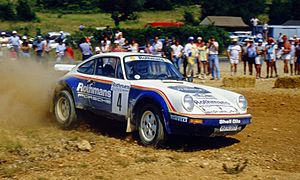
After his time with Opel, Toivonen joined the Rothmans-sponsored Porsche factory team for the 1984 European Rally Championship. He drove a Porsche 911 SC RS. This season was very successful for him. After a few early races, he won five rallies in a row and was leading the championship.
However, Toivonen also had a contract with Lancia for the World Rally Championship. Lancia wanted their driver, Carlo Capone, to win the European title. Toivonen's title hopes ended when he got a back injury and had to rest for a couple of months. He missed several events and finished second in the championship.
Toivonen's WRC contract with Lancia Martini was for five events. He first drove the Lancia 037 in Portugal. Even with little practice, he immediately took the lead and set fast times before crashing. After another crash in Greece, he finished third at his home event, the 1000 Lakes Rally. These were his only WRC events that season because of his back injury. Toivonen decided to become a full-time Lancia driver for the 1985 season.
Lancia Team (1985–1986)
The 1985 season started badly for Toivonen. He crashed his Lancia 037 into a wall at the Rally Costa Smeralda, hurting his back and breaking bones in his neck. In May, Lancia drivers Toivonen and Alén lost their teammate, Attilio Bettega, who died in a crash during the Tour de Corse.
Toivonen returned from his injuries at the 1000 Lakes Rally in August and finished fourth. He then finished third at the next rally in Sanremo. The Lancia 037 was a rear-wheel drive car with 325 horsepower, which was much less powerful than the Audi and Peugeot cars.
For the last event of the season, the RAC Rally, Lancia introduced the new Lancia Delta S4. This car had all-wheel drive and was both supercharged and turbocharged, making it incredibly powerful. It could go from 0 to 60 mph in just 2.3 seconds on a gravel road! The Delta S4 was a huge success. Toivonen won the rally, and his teammate Alén finished second. Even though Toivonen only competed in four world rallies in 1985, his results placed him sixth overall in the championship, his best career finish.
The 1986 season began with a strong win for Toivonen at the Monte Carlo Rally with his new co-driver, Sergio Cresto. His father, Pauli Toivonen, had won the same event 20 years earlier. Henri's victory made his father say, "now the name of Toivonen has been cleared." This win made Henri the favorite to win the championship.
However, at the Swedish Rally, he had to stop due to an engine problem while leading. At the next rally in Portugal, a car crashed into the crowd, killing three spectators and injuring many. Toivonen and other factory team drivers decided to stop competing in the event, even though Lancia was not happy about it. Toivonen reportedly said that "the Lancia team will not accept anything but a win."
During the Portuguese rally, it's often said that Toivonen tested his Delta S4 at the Estoril circuit. He supposedly set a lap time that would have placed him among the top Formula One cars. While this story has been debated, some sources suggest he was indeed incredibly fast. Despite these challenges, Toivonen remained a top contender for the championship because no one seemed able to match his speed.
His Final Race
The 1986 Tour de Corse rally, held on narrow and winding mountain roads in Corsica, began on May 1. Toivonen was feeling unwell with the flu and a sore throat, but he insisted on driving. He had lost his championship lead in the previous rallies and wanted to win. Despite being sick, he was winning stage after stage and leading the rally by a lot.
After the first part of the rally, Toivonen said:
This rally is insane, even though everything is going well at the moment. If there is trouble, for sure, I am completely finished."
Toivonen felt the car was too fast and powerful for the twisty roads of Corsica. He found it very hard to control the 600 horsepower Lancia and said it was very tiring. Other rally drivers also worried about how powerful the Group B cars were. In a short interview before starting the 18th stage, Toivonen said what would be his last public words:
Today, we have driven more than the whole distance of the 1000 Lakes Rally (Finnish Rally). After 4 hours of driving- it's hard to keep up with the speed. So, with a modern car like this, it's just impossible to race here. It's physically exhausting and the brains can't keep up with it anymore.
On May 2, during the second part of the rally, Toivonen's Lancia went off the road at a sharp left turn. The car fell into a ravine and landed on its roof. The fuel tank, located under the driver's seat, broke open and exploded. The explosion happened very quickly, and Toivonen and his co-driver, Sergio Cresto, died instantly. The fire was so intense that the car, made of fast-burning materials, was completely destroyed. Henri Toivonen left behind his wife, Erja, and two young children, Markus and Arla. Sergio Cresto was single.
Toivonen's crash is still a mystery because no one saw it happen up close. A spectator filmed it from further away, but the video couldn't show why the crash happened. No race officials were near the scene to see the smoke, and no one at the finish line knew about the crash. Lancia engineers couldn't figure out the cause because the car was so badly burned.
Some people, including fellow driver Malcolm Wilson, later claimed that Toivonen had suffered from sudden blackouts since his 1985 crash but didn't tell his team. However, the exact cause of the crash remains unknown.
What Happened Next
Within hours of Toivonen's crash, Jean-Marie Balestre and the motorsport organization FISA decided to ban Group B cars from competing in the 1987 season. This also meant that the planned Group S cars, which were even more extreme, were cancelled. Car manufacturers were left with cars they couldn't race. Audi and Ford immediately stopped their Group B racing programs.
Before these crashes, many people, including drivers, had warned that the powerful Group B cars were becoming too dangerous. FISA was criticized for not acting sooner. An investigation later showed that drivers' reactions were too slow for the speed of Group B cars, and their eyes couldn't focus fast enough between corners. However, because the cars were so fast, rallying was more popular than ever with fans. Some people also criticized FISA for overreacting to Toivonen's accident, saying that Group B cars could have been made safer with changes to fuel systems and crowd control. Group B cars have been called "too fast to race."
His Legacy
Toivonen was known as a great driver on both loose surfaces (like gravel and snow) and paved roads. He found it hard to choose between circuit racing and rallying. Even after becoming a rally driver, he still competed in some circuit races. Eddie Jordan, a famous racing team owner, called Toivonen's performances "incredible" and compared him to Ayrton Senna, a Formula One legend. Jordan believed Toivonen would have won Formula One races if he had lived.
During his World Rally Championship career, Toivonen competed in 40 rallies. He won three times, finished on the podium nine times, and won 185 special stages. In his last five rallies, he either won or had to stop early. He was at the peak of his career with the Lancia Delta S4, a car that suited his driving style. However, Toivonen admitted the car was difficult to drive: "I may have won the RAC Rally with Lancia, but I just did not know how to drive it. It seemed to have a mind of its own." Lancia team boss Cesare Fiorio later said that Toivonen was the only driver who could truly control the Delta S4.
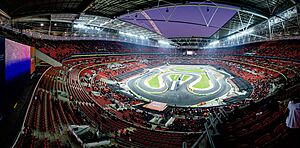
In an article after his death, rally writer Martin Holmes called Toivonen a "rebel driver." He showed that young drivers could succeed in rallying, a sport usually dominated by older, more experienced drivers. However, Toivonen sometimes had high-speed accidents because he pushed the limits. His career almost ended in 1985 when he was nearly paralyzed in a crash. The World Rally Archive's Hall of Fame now calls him an "icon for one of the most controversial periods of rallying."
Toivonen was buried in Espoo, Finland. In Corsica, a special marble slab was placed at the corner where he crashed, dedicated to him and Sergio Cresto. There is always an unopened bottle of Martini there, a nod to his Martini-sponsored Lancia team. A local person places fresh flowers there every day.
In 1988, former rally driver Michèle Mouton organized the first Race of Champions to remember Toivonen. This event originally featured only rally drivers but later included stars from Formula One and NASCAR. The Henri Toivonen Memorial Trophy is still given to the individual winner of this event every year.
Another award, the Henri Toivonen Grand Attack Trophy, was given by Peugeot to drivers who showed the same spirit as the young Finn. In 2006, Toivonen was honored at the Neste Oil Rally Finland. An exhibition about him opened, attended by his former teammate Markku Alén and his brother Harri Toivonen. Harri Toivonen stopped racing in 2002, ending the Toivonen family's 40-year history in motorsports.
Images for kids
-
Toivonen driving a Porsche 911 SC RS at the 1984 Mille Pistes
-
2007 Race of Champions at Wembley Stadium.
See also
 In Spanish: Henri Toivonen para niños
In Spanish: Henri Toivonen para niños


